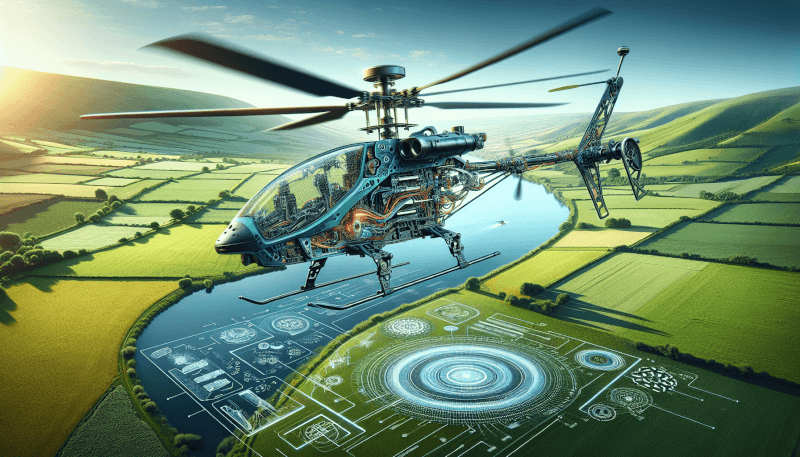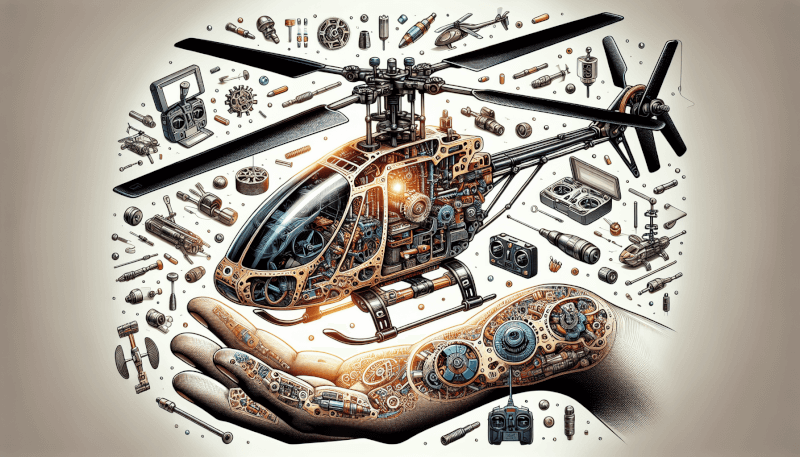Have you ever found yourself fascinated by the intricate movements and precision control of remote control (RC) helicopters? These small flying machines seem to defy gravity as they effortlessly soar through the air and perform agile maneuvers. In this article, we will explore the fascinating science behind how RC helicopters work. From the advanced aerodynamics that keep them aloft to the intricate mechanics that allow for control and stability, you will gain a deeper understanding of the technology that powers these impressive miniature flying marvels. So, buckle up and get ready to explore the science that takes RC helicopters to new heights!

Introduction
RC helicopters, short for Radio Controlled helicopters, are miniature model aircraft that can be controlled remotely using a dedicated transmitter. These helicopters have gained immense popularity over the years, captivating enthusiasts of all ages. From their nimble maneuverability to their ability to perform stunning aerobatics, RC helicopters offer an exciting and immersive experience for pilots. In this article, we will delve into the world of RC helicopters, exploring their components, aerodynamics, controls, flight modes, power sources, challenges, advancements, and safety considerations.
Definition of RC Helicopters
RC helicopters are scale models of real-life helicopters that are operated through remote control rather than having an onboard pilot. These miniature aircraft replicate the features and performance aspects of their full-sized counterparts, providing an engaging and realistic flying experience. Powered by electric, gasoline, or nitro engines, RC helicopters allow enthusiasts to enjoy the thrill of flight without leaving the ground.
Popularity of RC Helicopters
The popularity of RC helicopters can be attributed to several factors. First and foremost, they offer a fascinating and immersive hobby for individuals of all ages. Piloting an RC helicopter allows you to experience the joy of flying without the risks and costs associated with full-scale aviation. Furthermore, the accessibility of RC helicopters has greatly increased with advancements in technology, making them more affordable and user-friendly. This has attracted a larger audience and fostered a vibrant and inclusive community of RC helicopter enthusiasts around the world.
Brief History of RC Helicopters
The history of RC helicopters dates back to the mid-20th century when remote control technology began to emerge. In the early years, RC helicopters were bulky and challenging to control due to limited technological advancements. However, as the years progressed, improvements in materials, electronics, and aerodynamics allowed for the development of more stable and maneuverable models. Today, RC helicopters have become sophisticated machines capable of performing intricate aerobatics and providing an exhilarating flying experience.

Components of an RC Helicopter
To understand how RC helicopters work, it is essential to familiarize yourself with their key components. These components work together harmoniously to ensure stable flight and precise control.
Main Rotor
The main rotor is the most significant component of an RC helicopter as it generates the lift required for flight. It consists of several rotor blades that spin in a circular motion, producing an upward force that counteracts the weight of the helicopter. The main rotor is powered by the engine and is responsible for most of the helicopter’s maneuverability.
Tail Rotor
The tail rotor, located at the back of the helicopter, serves a vital role in counteracting the torque produced by the main rotor. It generates a sideways thrust that helps maintain the helicopter’s stability and prevents it from spinning uncontrollably. The tail rotor is controlled by the pilot through the transmitter to ensure accurate yaw control.
Gyroscopes
Gyroscopes are crucial stability-enhancing components in RC helicopters. They detect any changes in the helicopter’s orientation and activate control adjustments to maintain stability. With their rapid response capabilities, gyroscopes help counteract external forces and ensure smooth flight.
Servos
Servos are small electronic devices that actuate the movements of various control surfaces on the RC helicopter. They receive signals from the transmitter and convert them into precise mechanical movements, allowing the pilot to control the helicopter’s flight characteristics effectively.
Speed Controller
The speed controller, also known as an ESC (Electronic Speed Controller), regulates the power delivery to the motor. By adjusting the voltage and current supplied to the motor, the speed controller allows the pilot to control the speed and responsiveness of the helicopter.
Battery
The battery serves as the primary power source for an electric RC helicopter. It provides the necessary electrical energy to the motor, servos, and other electronic components. The choice of battery greatly impacts flight performance in terms of duration, power output, and weight.
Aerodynamics of RC Helicopters
Understanding the key principles of aerodynamics is essential in comprehending how RC helicopters achieve flight and maneuverability. Let’s explore the key aspects of aerodynamics in RC helicopters:
Principle of Lift
The principle of lift, which applies to all aircraft, is the primary mechanism responsible for keeping an RC helicopter airborne. According to Bernoulli’s principle, air moving faster over the curved top surface of the rotor blades creates lower air pressure compared to the bottom surface, resulting in an upward force known as lift. This lift force counteracts the helicopter’s weight and enables it to fly.
Main Rotor Design
The design of the main rotor plays a vital role in determining the helicopter’s aerodynamic performance. The shape, size, and angle of attack of the rotor blades impact the amount of lift generated, the helicopter’s stability, and its ability to perform agile maneuvers. Various rotor designs, such as symmetrical and asymmetrical airfoils, can be used to optimize lift and efficiency.
Main Rotor Collective Pitch Control
Collective pitch control allows the pilot to adjust the angle of attack of all the main rotor blades simultaneously. By increasing or decreasing the collective pitch, the pilot can generate more or less lift, respectively. This control mechanism enables the helicopter to ascend, descend, and maintain altitude.
Cyclic Pitch Control
Cyclic pitch control, also known as cyclic control, allows the pilot to tilt the main rotor blades cyclically during rotation. By varying the pitch of each rotor blade at specific points in the rotation, the pilot can control the direction and roll of the helicopter. This control mechanism enables the helicopter to move forward, backward, and sideways.
Tail Rotor Function
The tail rotor serves a critical role in maintaining the helicopter’s stability and controlling its yaw. By varying the pitch of the tail rotor blades, the pilot can counteract the torque generated by the main rotor. The tail rotor allows the helicopter to yaw left or right, ensuring stable and controlled flight.

RC Helicopter Controls
To navigate an RC helicopter effectively, it is essential to understand the various controls involved. Let’s explore the key controls used in piloting an RC helicopter:
Transmitter and Receiver
The transmitter is the device held by the pilot that sends control signals to the helicopter. It communicates wirelessly with the receiver onboard the helicopter, which interprets the signals and activates the corresponding control mechanisms.
Throttle Control
Throttle control manages the power output of the helicopter’s motor. By adjusting the throttle stick or lever on the transmitter, the pilot can increase or decrease the rotor speed, controlling the helicopter’s climb, descent, and hover.
Collective Pitch Control
Collective pitch control allows the pilot to adjust the pitch of all the main rotor blades simultaneously. By manipulating the collective pitch stick or lever on the transmitter, the pilot can control the helicopter’s altitude, making it ascend or descend.
Cyclic Control
Cyclic control enables the pilot to tilt the main rotor blades cyclically, controlling the helicopter’s forward, backward, and sideways movements. The cyclic control stick or lever on the transmitter is used to manipulate the cyclic pitch of the rotor blades, determining the direction and roll of the helicopter.
Tail Rotor Control
Tail rotor control, operated using the rudder stick or lever on the transmitter, allows the pilot to control the yaw of the helicopter. By manipulating the tail rotor’s pitch, the pilot can make the helicopter rotate left or right while maintaining stability in flight.
Dual-Rate and Exponential Settings
Some transmitters feature dual-rate and exponential settings, which provide pilots with additional control customization. Dual-rate settings enable the pilot to adjust the sensitivity and travel range of the control inputs, allowing for more precise control in different flight conditions. Exponential settings allow for nonlinear control response, where small control inputs result in gradual movements initially but eventually become more sensitive.
Flight Modes of RC Helicopters
RC helicopters can perform various flight modes, each with its own set of characteristics and challenges. Let’s explore the different flight modes commonly seen in RC helicopter flying:
Hovering
Hovering is one of the fundamental flight modes for RC helicopters. It involves maintaining a stable position in mid-air, with the helicopter’s altitude and orientation held constant. Hovering requires precise control inputs and is a foundational skill for mastering other flight modes.
Forward Flight
Forward flight involves moving the RC helicopter in a straight line while maintaining stability and control. The pilot adjusts the cyclic control to tilt the main rotor blades forward, causing the helicopter to move in the desired direction. Forward flight allows for longer distances to be covered and is a stepping stone to more advanced maneuvers.
Sideways Flight
Sideways flight entails moving the RC helicopter horizontally, parallel to the ground, in either the right or left direction. The pilot adjusts the cyclic control to tilt the helicopter’s main rotor blades sideways, causing a lateral movement. Sideways flight adds further maneuvering options and increases the pilot’s control capabilities.
Backward Flight
Backward flight involves moving the RC helicopter in a straight line with the tail-end leading. The pilot employs cyclic control to tilt the main rotor blades backward, resulting in the helicopter’s reverse movement. Backward flight requires precise control application and coordination to maintain stability and control throughout the maneuver.
Turning Maneuvers
Turning maneuvers refer to the rotation of the RC helicopter around its vertical axis. These maneuvers involve coordinated control inputs between the cyclic control, collective pitch control, and tail rotor control. Different turning techniques, such as nose-in turns and tail-in turns, allow the pilot to change the helicopter’s direction while maintaining stability and control.
3D Aerobatics
3D aerobatics showcase the full potential of RC helicopters, allowing pilots to perform complex and dynamic maneuvers. These maneuvers, such as flips, loops, rolls, and inverted flying, require advanced control skills and knowledge of the helicopter’s capabilities. 3D aerobatics emphasize the pilot’s mastery of precise maneuvers and exhilarating flight techniques.

Stabilization Systems
Stabilization systems play a crucial role in enhancing the flight characteristics and stability of RC helicopters. Let’s explore some common stabilization systems used in RC helicopters:
Flybar System
The flybar system has been traditionally used in RC helicopters to enhance stability. It consists of a horizontal bar positioned above the main rotor blades. By detecting changes in the helicopter’s orientation, the flybar counteracts undesired movements and assists in maintaining stability during flight.
Flybarless System
Flybarless systems represent a more advanced approach to stabilization in RC helicopters. These systems eliminate the flybar and rely on gyroscopes and advanced flight controllers to stabilize the helicopter. Flybarless systems provide greater responsiveness, agility, and maneuverability while minimizing mechanical complexity.
Electronic Stability Control
Electronic Stability Control (ESC) systems further enhance stability by incorporating advanced sensors and algorithms. These systems continuously monitor the RC helicopter’s position, attitude, and movement, and automatically make corrections to maintain stability and mitigate any unwanted deviations. ESC systems are particularly useful for beginners and can be adjusted based on the pilot’s skill level.
Heading Hold Gyro
Heading hold gyros are specifically designed to maintain the RC helicopter’s desired heading. By continuously adjusting the tail rotor pitch, the heading hold gyro counteracts any unwanted yaw deviations, ensuring stable flight. This feature is particularly valuable during turning maneuvers and hovering to maintain precise control.
Power Sources for RC Helicopters
RC helicopters utilize different power sources to drive the motor and other electronic components. Let’s explore the common power sources used in RC helicopters:
Electric Power
Electric power has become the most popular choice for RC helicopters due to its efficiency, ease of use, and lower maintenance requirements. Electric RC helicopters are powered by rechargeable batteries, typically LiPo (Lithium Polymer) batteries, which offer a high power-to-weight ratio and extended flight times. Electric power allows for quieter operation and is environmentally friendly.
Gasoline Power
Gasoline-powered engines are less common in RC helicopters but still have a significant presence, especially in larger scale models. Gasoline engines offer increased power output and longer flight durations compared to electric counterparts. However, they require special fueling procedures, regular engine maintenance, and are more complex to operate.
Nitro Power
Nitro-powered engines were once prevalent in RC helicopters but have gradually faded in popularity. Nitro engines utilize a mixture of nitromethane, methanol, and oil to generate power. While nitro power provides a unique sound and more realistic flying experience, it requires careful tuning, frequent maintenance, and additional safety considerations.

Challenges and Limitations of RC Helicopters
Flying RC helicopters is a thrilling endeavor, but it also presents challenges and limitations that pilots must consider. Let’s explore some of the common challenges and limitations faced by RC helicopter pilots:
Stability Issues
RC helicopters, especially when operated by beginners, can be inherently unstable due to their small size and complex control coordination. Achieving and maintaining stability during flight requires practice and precise control inputs. Wind sensitivity, turbulence, and abrupt control inputs can introduce instability, making flight control challenging.
Wind Sensitivity
RC helicopters are sensitive to wind, particularly gusty or turbulent conditions. Even a slight breeze can impact stability and make control more difficult. Pilots must be aware of weather conditions and adjust their flying techniques accordingly. Smaller RC helicopters are generally more affected by wind compared to larger scale models.
Complex Control Coordination
Flying an RC helicopter requires intricate control coordination, particularly in advanced maneuvers and aerobatics. Manipulating multiple controls simultaneously while maintaining stability demands skill, muscle memory, and quick reflexes. Pilots must invest time and effort into developing their control coordination abilities to fly with finesse and precision.
Higher Skill Requirements
Compared to other RC aircraft, such as airplanes or drones, RC helicopters generally demand a higher level of skill and experience to operate successfully. The complex mechanics, control coordination, and sensitivity of RC helicopters require pilots to invest significant time in practice and learning. Patience, perseverance, and a willingness to continuously improve are crucial to mastering the art of piloting an RC helicopter.
Advancements in RC Helicopter Technology
Over the years, advancements in technology have greatly contributed to the evolution and improvement of RC helicopters. Let’s explore some notable advancements that have propelled RC helicopter technology forward:
Brushless Motors
The introduction of brushless motors has revolutionized RC helicopter power systems. Brushless motors are more efficient, powerful, and reliable compared to their brushed counterparts. They offer increased torque, longer lifespan, and reduced maintenance requirements. Brushless motors have significantly enhanced the overall performance and flight characteristics of RC helicopters.
LiPo Batteries
The development of LiPo (Lithium Polymer) batteries has greatly improved the power source options for RC helicopters. LiPo batteries offer higher energy density, lighter weight, and improved discharge rates compared to traditional NiMH (Nickel Metal Hydride) batteries. This advancement has resulted in longer flight times, increased power output, and reduced battery weight.
Microcontrollers and Flight Controllers
The integration of microcontrollers and flight controllers in RC helicopters has enhanced their stability, responsiveness, and overall flight performance. These sophisticated electronic devices can monitor the helicopter’s orientation, attitude, and movement in real-time and make rapid adjustments to maintain stability. Microcontrollers and flight controllers provide pilots with increased flight control, autopilot capabilities, and advanced features such as programmable flight modes.
Improved Materials and Durability
Advancements in composite materials, such as carbon fiber and reinforced plastics, have significantly improved the durability and structural integrity of RC helicopters. These lightweight yet robust materials offer increased resistance to impacts, vibrations, and stress. Improved materials have allowed for the design and manufacturing of more resilient and reliable RC helicopters that can withstand challenging flight conditions.
Safety Considerations for RC Helicopters
While flying RC helicopters is an exciting and enjoyable hobby, it is crucial to prioritize safety at all times. Let’s explore some important safety considerations for RC helicopter pilots:
Risk of Injury
RC helicopters, although scaled-down models, can still pose a risk of injury if not operated responsibly. The spinning rotor blades can cause severe cuts and injuries if they come into contact with body parts or other objects. It is imperative to maintain a safe distance from the helicopter during flight and ensure no people or animals are in close proximity to the operating area.
Safe Flying Practices
Adhering to safe flying practices is essential to minimize the risk of accidents and injuries. Before each flight, carefully inspect the RC helicopter for any damaged or worn-out components. Ensure that the flying area is clear of obstacles and avoid flying near power lines, trees, or busy public areas. It is recommended to fly in designated RC flying sites where other pilots can provide guidance and assistance if needed.
Adherence to Regulations
Depending on your location, there may be specific regulations and guidelines governing the operation of RC helicopters. Familiarize yourself with these regulations and comply with them to ensure responsible and legal flying. Pay attention to altitude restrictions, flight boundaries, and any permits or licenses required to operate RC helicopters in certain areas.
Maintenance and Inspection
Regular maintenance and inspection of your RC helicopter are critical to ensuring safe and reliable operation. Routinely check the mechanical components, electronics, and power systems for any signs of wear, damage, or loose connections. Follow the manufacturer’s recommendations for maintenance intervals and procedures. Properly store and transport the helicopter to prevent any accidental damage.
In conclusion, RC helicopters offer a thrilling and immersive flying experience for enthusiasts of all ages. From their complex aerodynamics to their precise controls, RC helicopters represent a perfect blend of science, engineering, and skill. Whether you are a beginner exploring the basics or an experienced pilot pushing the boundaries of 3D aerobatics, the world of RC helicopters is full of excitement and opportunities for learning and growth. By understanding the components, mastering the controls, and prioritizing safety, you can embark on a thrilling and rewarding journey as an RC helicopter pilot. So, grab your transmitter, head out to the flying field, and let your imagination take flight!


